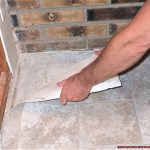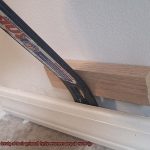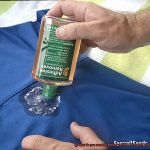Picture this: you’re in the zone, working on a kick-ass creative project, fixing up something around the house, or preparing a killer school presentation. You grab that trusty multi-purpose glue, relying on it to keep everything intact. But hold up. One slip of the hand and bam. A glob of glue lands where it shouldn’t, leaving you stuck in a sticky situation. We’ve all been there, and that moment of panic hits hard as you frantically ask yourself, “How on earth do I get rid of this stubborn multi-purpose glue?”
Well, fret not my friend, because in this blog post we’re about to unleash the secrets to liberate yourself from even the stickiest adhesive mishaps. Whether you’ve managed to glue fabric to fabric, glass to glass, plastic to plastic – or even worse – your own skin to something else entirely (ouch.), we’ve got your back.
With our arsenal of nifty tips and tricks at your disposal, we’ll shed light on various methods for removing multi-purpose glue so you can bid farewell to those gooey nightmares once and for all. From everyday household items that magically double as glue-busters to commercial solvents specially crafted for this very purpose, we’ll explore the most effective techniques guaranteed to rid you of that pesky stickiness.
But wait. Before diving headfirst into battle with that clingy adhesive monster, we’ll discuss the importance of patience and careful application when dealing with different surfaces. Get ready for a step-by-step guide tailored specifically for each sticky situation you might encounter. Plus, we won’t leave you hanging – we’ll also reveal some top-notch preventive measures so you can focus on unleashing your creative genius without worrying about becoming a human adhesive strip.
So buckle up and prepare for the ultimate liberation from the clutches of multi-purpose glue. It’s time to reclaim control of your projects and become a true master of glue removal. With our invaluable insights and practical advice, you’ll learn how to turn sticky dilemmas into smooth solutions, empowering yourself as the ultimate glue-removing extraordinaire.
What is Multi-Purpose Glue?
Contents
- 1 What is Multi-Purpose Glue?
- 2 How to Remove Multi-Purpose Glue Using Heat
- 3 How to Remove Multi-Purpose Glue Using Solvents
- 4 How to Remove Multi-Purpose Glue from Delicate Surfaces
- 5 Freezing Methods for Removing Multi-Purpose Glue
- 6 Safety Precautions to Consider When Removing Multi-Purpose Glue
- 7 Common Mistakes Made When Removing Multi-Purpose Glue
- 8 Tips for Effective Removal of Multi-Purpose Glue
- 9 Conclusion
In the realm of adhesives, one product reigns supreme for its adaptability and dependability – multi-purpose glue. Whether you’re a master crafter, a DIY enthusiast, or simply someone in need of a strong adhesive for household repairs, multi-purpose glue is an indispensable tool. In this captivating exploration, we will dive deep into the world of multi-purpose glue, uncovering its essence, mechanics, and the boundless possibilities it offers.
Unveiling the Enigma: What is Multi-Purpose Glue?
Multi-purpose glue, also known as all-purpose glue, is a remarkable adhesive that possesses the unique ability to bond an extensive range of materials together. From delicate paper and fabric to resilient wood and metal, this adhesive transcends barriers to create enduring connections across diverse surfaces. Its inherent versatility obliterates the need for a myriad of specialized adhesives, making it an unparalleled choice for countless projects.
Unleashing the Power: Key Features and Composition:
One of the most awe-inspiring aspects of multi-purpose glue is its unparalleled adaptability. While other adhesives cater exclusively to specific materials or applications, multi-purpose glue thrives on versatility. This makes it an indispensable companion for crafts, DIY projects, and household repairs alike.
Presented in liquid form, multi-purpose glue manifests itself in either ethereal white or crystal-clear hues. Application methods are as diverse as its bonding capabilities; brushes, squeeze bottles, and applicator tips all serve as conduits for this magical adhesive. Rapid drying properties ensure swift formation of robust bonds.
Most multi-purpose glues are water-based concoctions that feature polymers as their primary ingredient. These polymers bestow upon the adhesive its remarkable bonding qualities, allowing it to adhere effectively to an assortment of surfaces. However, it is important to acknowledge that the strength of the bond may vary depending on the specific materials involved.
Harnessing the Magic: Practical Applications of Multi-Purpose Glue:
Now that we have unraveled the essence of multi-purpose glue and its composition, let us embark on a journey through the myriad of ways it can be harnessed:
How to Remove Multi-Purpose Glue Using Heat
Accidents happen, and when multi-purpose glue finds its way onto surfaces, it can seem like an irreversible disaster. But fear not. I’m here to unveil the secret weapon in your cleaning arsenal: heat. Using heat to remove multi-purpose glue is a tried-and-true method that softens the adhesive, enabling you to easily scrape it off without causing harm. So grab your hairdryer or iron, and let’s dive into the art of ungluing.
Gather the Tools of Success:
Before embarking on your glue removal mission, assemble the essential materials: a hairdryer or iron, a trusty plastic scraper or credit card, and a clean cloth or paper towel. These tools will be your allies in this sticky battle, ensuring a victorious outcome without collateral damage.
Method 1: Taming with Hairdryer Heat:
For those wielding a hairdryer, set it to its highest heat setting. Position the hairdryer a few inches away from the glue spot, and commence a mesmerizing dance of back-and-forth movements. As the hot air engulfs the glue, its stubborn grip will begin to loosen, rendering it softer and more malleable.
Gentle Liberation:
Once the glue has succumbed to the heat and achieved a state of mushiness, employ your trusty plastic scraper or credit card to liberate it from the surface. Employ gentle pressure while scraping, mindful not to unleash excessive force or deploy sharp objects that may leave undesirable marks or scratches.
Method 2: Iron’s Subtle Power:
For those who prefer the steady hand of an iron, begin by laying a clean cloth or paper towel over the affected area to protect the surface beneath. Set the iron to a low or medium heat setting without steam, and tread cautiously. Place the iron atop the cloth-covered glue, exerting a gentle but persistent pressure.
Enter the Circular Symphony:
Engage the iron in a graceful waltz of circular motions for approximately 10-15 seconds, allowing the heat to permeate the adhesive. Lift the iron with delicate anticipation, inspecting whether the glue has surrendered to the warmth. If it has, wield your plastic scraper or credit card to delicately scrape off the softened glue.

Embrace Safety Precautions:
While using a heat gun, remember to don protective gloves and goggles, as its ferocious heat demands respect. Keep the heat gun in constant motion to prevent scorching or overheating the surface. Safety should always be your trusted companion on this ungluing endeavor.
How to Remove Multi-Purpose Glue Using Solvents
We’ve all experienced the frustration of accidentally getting multi-purpose glue on our favorite items or surfaces. But fret not. Armed with the right solvents and a little know-how, you can easily bid farewell to that sticky mess. In this comprehensive guide, we delve into the world of solvents and unveil their secrets to help you effortlessly remove multi-purpose glue.
Acetone: The Adhesive Assassin
When it comes to obliterating multi-purpose glue, acetone is a force to be reckoned with. Hiding within nail polish removers, this potent solvent breaks down the glue’s chemical bonds, paving the way for its swift removal. However, treading with caution is vital when using acetone on delicate surfaces like plastic or painted objects, as it may inflict damage or discoloration. To avoid any mishaps, always perform a patch test in an inconspicuous area.
To harness the power of acetone, immerse a cotton ball or cloth in this wonder solution and gently dab it onto the glued area. Allow it a few moments to penetrate the stubborn adhesive, then take up arms with a clean cloth or sponge and scrub in circular motions. Repeat these steps until every last trace of glue has been eradicated.
Isopropyl Alcohol: Your Trusty Sidekick
Enter isopropyl alcohol, a reliable companion in your quest to conquer multi-purpose glue. This alcohol-based solvent, readily available at pharmacies and supermarkets, proves itself safe for use on various surfaces. By dissolving the glue, isopropyl alcohol turns wiping away residue into a breeze.
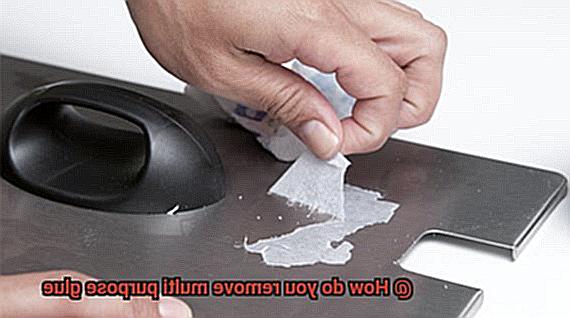
To wield isopropyl alcohol to its full potential, soak a cloth or cotton ball in this mighty elixir and gently rub it over the affected area until the glue begins to dissolve. Marvel as it effortlessly vanishes, leaving your glass or metal surfaces gleaming.
Citrus-Based Solvents: Nature’s Solution
For those seeking a more natural approach, look no further than citrus-based solvents—a gift from nature itself in tackling multi-purpose glue. Crafted from citrus oils, these biodegradable solvents work wonders by breaking down the adhesive properties of glue.
To harness the power of citrus-based solvents, apply them directly onto the glue, allowing them a few minutes to penetrate the adhesive. Armed with a plastic scraper or your trusty fingernail, gently scrape away the loosened glue. Witness the magic unfold as your once-sticky mess fades into oblivion.
How to Remove Multi-Purpose Glue from Delicate Surfaces
Removing multi-purpose glue from delicate surfaces can be a challenging task, requiring extra care to prevent damage. In this comprehensive guide, we will explore five gentle and effective methods for safely removing multi-purpose glue without compromising the integrity of your precious items.
Act Promptly to Prevent Set-In Stains:
When dealing with glue stains on delicate surfaces, time is of the essence. The longer the glue sits, the more difficult it becomes to remove. Therefore, it is crucial to take immediate action as soon as you notice a glue stain to prevent it from setting in.
Test the Method on an Inconspicuous Area:
Before embarking on the glue removal process, it’s essential to perform a patch test on a small, inconspicuous area of the surface. This precautionary step helps ensure that the chosen method does not cause any damage or discoloration to your delicate item.
Solvent Solutions: Acetone and Nail Polish Remover:
One effective method for removing multi-purpose glue from delicate surfaces is using solvents such as acetone or nail polish remover. However, it’s crucial to verify if your fabric or surface can tolerate these solvents before proceeding.
To utilize this method, apply a small amount of acetone or nail polish remover onto a clean cloth and gently dab at the glue stain. Avoid excessive rubbing, as it may spread the glue and potentially cause additional damage.<
Natural Alternatives: Vinegar and Oil:
For those who prefer natural ingredients, vinegar and oil can effectively dissolve glue stains from delicate surfaces. Keep in mind that vinegar may require repeated applications and some patience. Mix equal parts vinegar and water, dampen a cloth with the solution, and gently blot at the glue stain until it loosens.
Alternatively, oils like coconut oil or olive oil can help soften and dissolve the glue. Apply a small amount of oil onto a cloth and delicately rub it onto the stain. Allow the oil to sit for a few minutes before gently scraping off the softened glue with a plastic scraper or your fingernail.
Heat Method: A Gentle Alternative for Sensitive Fabrics:
When solvents or oils are not suitable for delicate fabrics, using heat can be an effective alternative. Cover the glued area with a clean cloth and carefully iron over it on a low heat setting. The heat will melt the glue, allowing it to transfer onto the cloth. Repeat this process with a clean section of the cloth until all traces of glue are removed.
Freezing Methods for Removing Multi-Purpose Glue
Prepare to embark on a frosty journey, dear reader, as we delve into the mesmerizing realm of freezing methods for banishing the relentless grip of multi-purpose glue. With the power of ice and compressed air at our disposal, we shall conquer the sticky adversary that plagues our cherished surfaces. So grab a warm drink and brace yourself for a chilling adventure into the world of liberation.
Ice Cubes or Ice Packs – The Classic Cool-Down:
Step into a winter wonderland as we unleash the timeless freezing method using ice cubes or ice packs. This age-old technique harnesses the power of cold to freeze the glue into submission.
- Place ice cubes directly on the glue, letting their icy touch work its magic for a few minutes.
- Witness as the frigid temperature hardens the glue, rendering it brittle and easier to handle.
- Armed with a plastic scraper or trusty credit card, gently scrape away the frozen glue.
- Remember to apply just enough pressure to remove the glue without causing damage to the surface beneath.
- If stubborn remnants remain, repeat the process until victory is achieved.
Compressed Air – The Arctic Gust:
For surfaces that demand a more delicate approach, we turn to the formidable can of compressed air. This method proves especially effective on electronics or glass.
- Embrace an inverted can as you unleash an arctic gust upon the glue’s stronghold.
- Witness as the extreme cold freezes and contracts the glue, weakening its tenacious grip.
- With grace and precision, wield a plastic scraper or credit card to gently peel away the now-frozen adhesive.
- Exercise caution to preserve delicate surfaces, ensuring no scratches mar their pristine beauty.
Glue Composition Matters:
While freezing methods generally triumph over multi-purpose glues, it’s crucial to acknowledge that not all adhesives are created equal. Some glues possess unique chemical compositions that render them more resistant to freezing. When faced with such stubborn foes, consider alternative methods tailored specifically to their composition.
Safety Precautions to Consider When Removing Multi-Purpose Glue
As we delve deeper into the art of removing multi-purpose glue, it is imperative that we prioritize safety precautions. Our mission is to conquer the sticky beast without encountering harm or accidents along the way. So, let’s embark on this journey and explore the safety measures you should consider.
First and foremost, don your trusty protective gloves. Multi-purpose glue may contain chemicals that don’t play well with your skin. By adorning your hands with gloves, you not only shield them from harm but also ensure a seamless removal process.
Now, let’s address the issue of ventilation. Some multi-purpose glues emit potent fumes that can leave you feeling lightheaded if inhaled excessively. To combat this, choose a well-ventilated workspace. Cracking open windows or setting up fans will keep the air flowing and minimize your exposure to those pungent vapors.
Moving on, it’s time to safeguard your precious eyes. Accidental splatters or drips of glue can spell trouble for your delicate peepers. To prevent any unfortunate encounters, don a pair of safety goggles or glasses throughout the removal process. Safety should always be at the forefront.
In our quest for safety, cleanliness and organization play a vital role. Spilled glue can transform surfaces into treacherous slopes, increasing the risk of falls or accidents. Therefore, promptly clean up any spills and maintain an orderly work area to minimize potential hazards.
Don’t underestimate the power of knowledge. Remember that instruction manual that accompanies your multi-purpose glue? It’s time to give it the attention it deserves. Different types of glue may require specific methods or solvents for effective removal. By following the manufacturer’s instructions diligently, you’ll ensure you’re equipped with the right techniques and materials for success.
Let’s talk about solvents and chemicals, shall we? These potent substances are often necessary for removing multi-purpose glue. However, they demand careful handling. Some solvents can be flammable or toxic, making it crucial to exercise caution. Read labels meticulously, work in a well-ventilated area, and don’t forget to wear the appropriate protective gear. Remember, safety is paramount.
Common Mistakes Made When Removing Multi-Purpose Glue
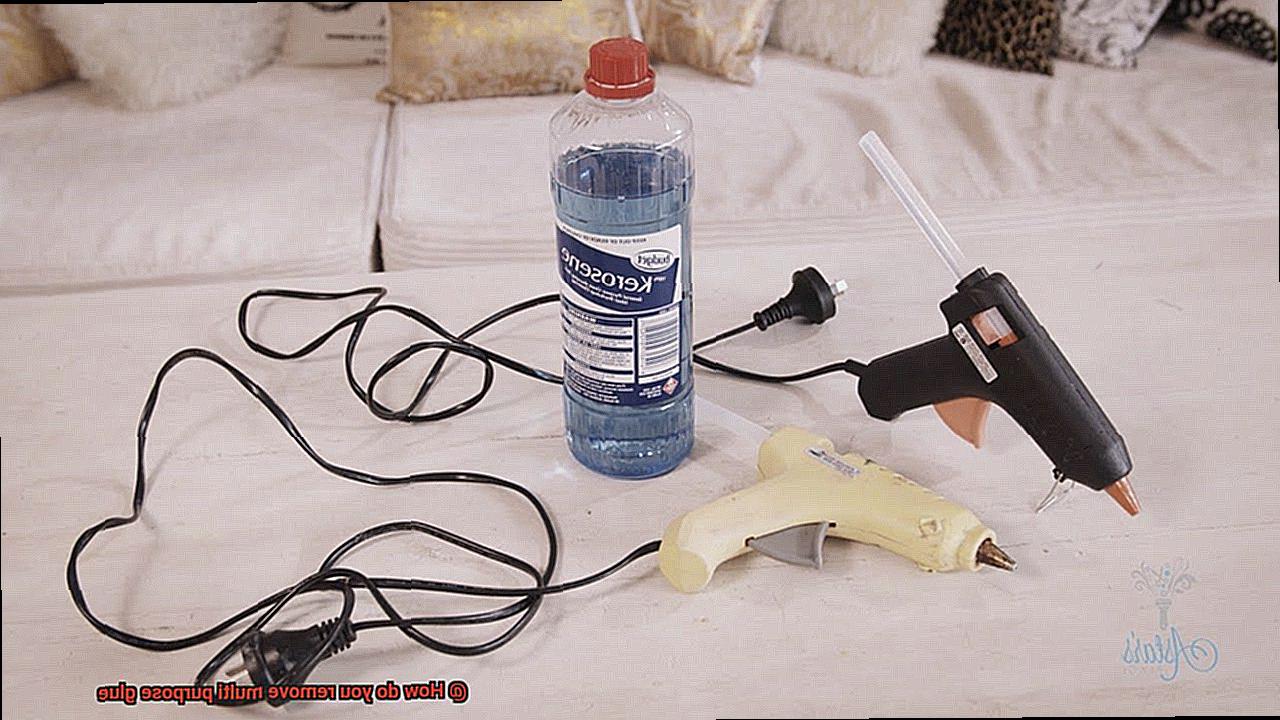
In this captivating guide, we will unveil the secrets to removing multi-purpose glue effectively, while steering clear of common mistakes. So, don your safety gear and prepare to conquer this adhesive challenge like a pro.
Mistake #1: The Aggressive Approach – Using Excessive Force or Abrasive Materials
Picture this: you’re faced with stubborn multi-purpose glue, and your instinct is to scrub or scrape it away with brute force. But beware. This can cause unintended damage, especially on delicate materials like fabric or wood. To preserve the integrity of your surface, adopt a gentle and patient approach when removing multi-purpose glue.
Mistake #2: The Wrong Weapon – Using the Wrong Type of Solvent or Cleaner
Multi-purpose glues come in different formulations, such as epoxy or cyanoacrylate, each requiring a specific solvent or cleaner for effective removal. Using the wrong one can render your efforts futile or even worsen the situation. Arm yourself with knowledge by researching the type of glue and consulting professionals if in doubt.
Mistake #3: Impatience is Not a Virtue – Not Allowing Enough Time for the Solvent to Work

Removing multi-purpose glue demands some waiting time. Rushing through the process can result in incomplete removal, leaving frustrating traces behind. Don’t let impatience sabotage your success. Follow the instructions provided by the manufacturer or conduct thorough research to determine the optimal removal time for your specific glue.
Mistake #4: The Neglected Test Patch
Imagine applying a solvent or cleaner to your entire surface only to discover that it damages or discolors it. Avoid this nightmare scenario by conducting a simple test patch beforehand. Different surfaces react differently to solvents, so it’s crucial to test a small, inconspicuous area first to ensure the best outcome.
Tips for Effective Removal of Multi-Purpose Glue
Don’t let multi-purpose glue get the best of you. We’ve got you covered with these tried and true tips for safely and effectively removing it from any surface. In this comprehensive guide, we’ll explore five proven methods that take into account different surfaces and adhesive bonds. Get ready to say goodbye to sticky situations once and for all.
Handle with Heat:
When it comes to tackling multi-purpose glue, heat is your secret weapon. Unleash the power of a hot air gun or blow dryer on the glued area. As the glue softens, gently scrape it away using a plastic scraper or even a trusty old credit card. Just remember, a delicate touch is essential to avoid any unwanted damage. Don’t let the heat get too intense, or you might end up with more than just glue to deal with.
Solvent Solutions:
To dissolve multi-purpose glue with ease, turn to solvents. Acetone, found in nail polish remover, is a reliable option for breaking down adhesive bonds. Soak a cotton ball or cloth in acetone and gently rub it in circular motions on the glue. Always test the solvent on a hidden spot first to ensure it won’t harm or discolor the surface. If you prefer an alternative, isopropyl alcohol can also work wonders, but exercise caution as certain surfaces may react sensitively to it.
Gentle Approach for Delicate Surfaces:
Delicate surfaces require a gentle touch when dealing with stubborn multi-purpose glue stains. Mix a small amount of dish soap with warm water and apply it to the affected area. Using a clean cloth, gently blot the glue until it lifts away without causing any damage. Remember, patience is key – repeat the process if necessary until every trace of glue disappears.
Freeze and Scrape:
For those hardened and stubborn glue spots, embrace the power of freezing. Place ice cubes or an ice pack on the glue, allowing it to harden. Once hardened, carefully scrape away the glue using a plastic scraper or trusty credit card. However, exercise caution with sensitive surfaces that may not appreciate extreme cold.
Read the Instructions:
Before embarking on your glue removal adventure, take a moment to read the instructions on the glue packaging. Some multi-purpose glues have specific recommendations for removal that can save you time and effort. Always follow the manufacturer’s guidelines to ensure a successful removal process tailored to your specific glue type.
39-D_SUMnQc” >
Conclusion
Removing multi purpose glue can be a tricky task, but with the right approach and some handy tips, you can get rid of it effectively.
From using common household items like vinegar and rubbing alcohol to specialized adhesive removers, the key is to act quickly and follow the proper steps.


